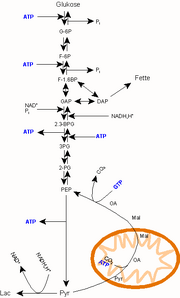Assessment |
Biopsychology |
Comparative |
Cognitive |
Developmental |
Language |
Individual differences |
Personality |
Philosophy |
Social |
Methods |
Statistics |
Clinical |
Educational |
Industrial |
Professional items |
World psychology |
Biological: Behavioural genetics · Evolutionary psychology · Neuroanatomy · Neurochemistry · Neuroendocrinology · Neuroscience · Psychoneuroimmunology · Physiological Psychology · Psychopharmacology (Index, Outline)

Diagram of Gluconeogenesis
Gluconeogenesis is the generation of glucose from other organic molecules like pyruvate, lactate, glycerol, and amino acids (primarily alanine and glutamine).
The vast majority of gluconeogenesis takes place in the liver and, to a smaller extent, in the kidney. This process occurs during periods of starvation or intense exercise and is highly endergonic.
Entering the pathway[]
Many 3- and 4-carbon substrates can enter the gluconeogenesis pathway. Lactate from anaerobic respiration in skeletal muscle is easily converted to pyruvate in the liver cells; this happens as part of the Cori cycle. However, the first designated substrate in the gluconeogenic pathway is pyruvate.
Oxaloacetate (an intermediate in the citric acid cycle) can also be used for gluconeogenesis. Amino acids, after their amino group has been removed, feeds into parts of the citric acid cycle, and can thus generate glucose in this pathway.
Most fatty acids cannot be turned into glucose unless the glyoxylate cycle is used, the exception being odd-chain fatty acids, which can yield propionyl CoA, a precursor for succinyl CoA. Fatty acids are regularly broken down into the two-carbon acetyl CoA, which becomes degraded in the citric acid cycle. In contrast, glycerol, which is a part of all triacylglycerols, can be used in gluconeogenesis.
Pathway[]
- Gluconeogenesis begins with the formation of oxaloacetate through carboxylation of pyruvate at the expense of one molecule of ATP, but is inhibited in the presence of high levels of ADP. This reaction is catalyzed by pyruvate carboxylase.
- Oxaloacetate is then decarboxylated and simultaneously phosphorylated by phosphoenolpyruvate carboxykinase to produce phosphoenolpyruvate. One molecule of GTP is hydrolyzed to GDP in the course of this reaction. Both reactions take place in mitochondria. Oxaloacetate has to be transformed into malate in order to be transported out of the mitochondria.
- Typically, the last step of gluconeogenesis is the formation of glucose-6-phosphate from fructose-6-phosphate by phosphoglucose isomerase. Free glucose is not generated automatically because glucose, unlike glucose-6-phosphate, tends to freely diffuse out of the cell. The reaction of actual glucose formation is carried out in the lumen of the endoplasmic reticulum. Here, glucose-6-phosphate is hydrolyzed by glucose-6-phosphatase, a regulated membrane-bound enzyme, to produce glucose. Glucose is then shuttled into cytosol by glucose transporters located in the membrane of the endoplasmic reticulum.
Regulation[]
Gluconeogenesis cannot be considered to be a reverse process of glycolysis, as the three irreversible steps in glycolysis are bypassed in gluconeogenesis. This is done to ensure that glycolysis and gluconeogenesis do not operate at the same time in the cell, making it a futile cycle.
The majority of the enzymes responsible for gluconeogenesis are found in the cytoplasm; the exception is pyruvate carboxylase, which is located in the mitochondria. The rate of gluconeogenesis is ultimately controlled by the action of a key enzyme fructose-1,6-bisphosphatase.
Most factors that regulate the activity of the gluconeogenesis pathway do so by inhibiting the activity of key enzymes. However, both acetyl CoA and citrate activate gluconeogenesis enzymes (pyruvate carboxylase and fructose-1,6-bisphosphatase, respectively).
External links[]
- The chemical logic behind gluconeogenesis at ufp.pt
- Overview at indstate.edu
- Interactive diagram at uakron.edu
de:Gluconeogenese fr:Néoglucogenèse he:גלוקונאוגנזה nl:Gluconeogenese pt:Gliconeogênese fi:Glukoneogeneesi sv:Glukoneogenes zh:糖异生
| This page uses Creative Commons Licensed content from Wikipedia (view authors). |